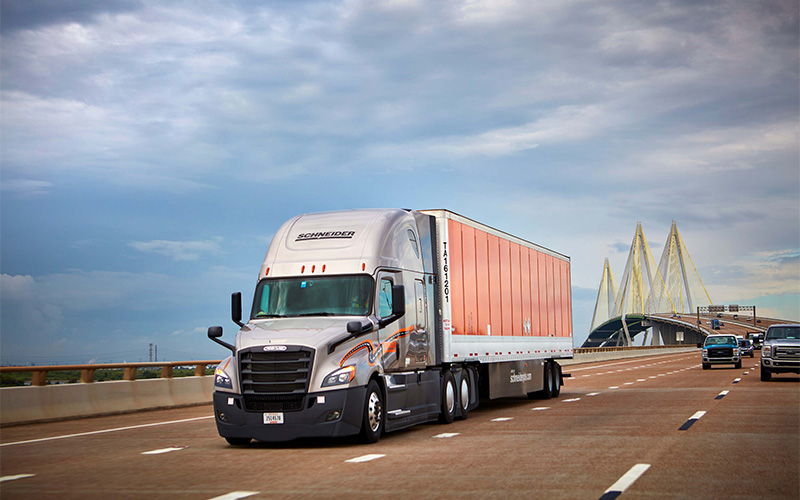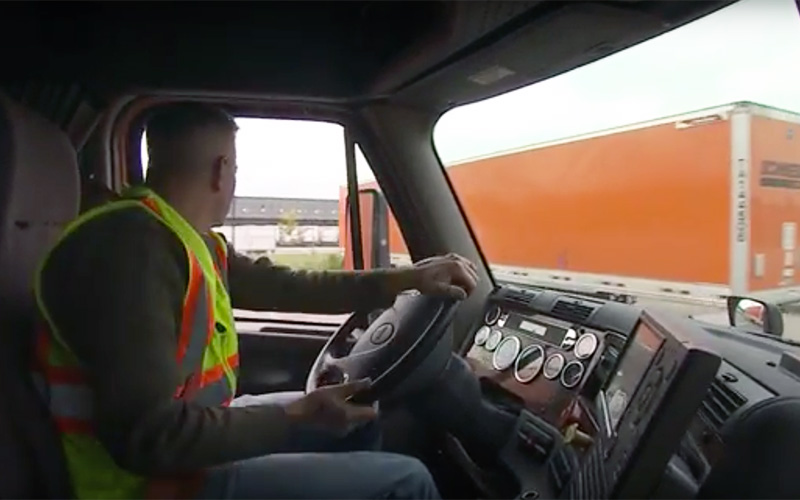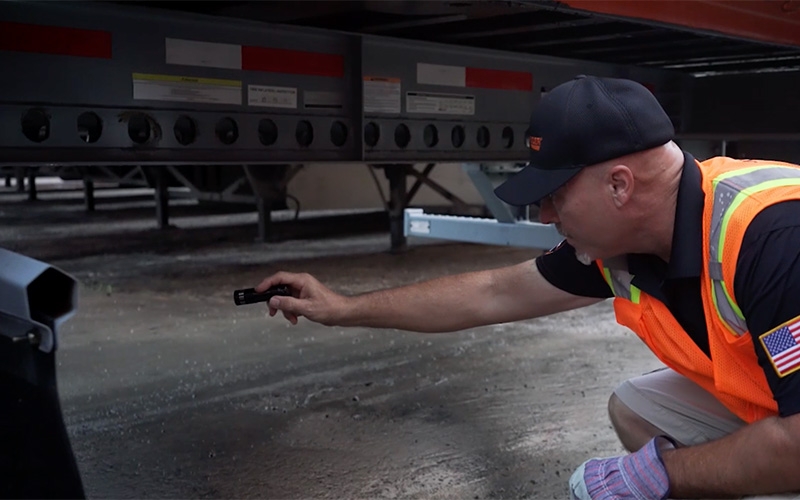Becoming a successful and safe truck driver doesn’t end when you obtain your CDL. Have an always-learning and “Safety First and Always” mindset to further your skills and confidence. These safety tips for truck drivers cover many steps of a typical day on the job: from pre-trip, to on the road, arriving and post-trip.
The following safety and defensive driving tips for truck drivers are great reminders no matter how much experience you’ve had.
Pre-trip: 5 safety tips before you hit the road
“How can I be a safe truck driver?” It all starts before you even get in the driver’s seat!
1. Take care of yourself.
The most important asset in the truck is you, so do all you can to become a healthy truck driver by eating, exercising and sleeping well.
2. Plan your route with care.
Make sure you stay up to date on weather, road conditions, traffic patterns, construction, low bridges and regulations that vary by state. These are just a few of the many important trip planning tips truck drivers should consider before they hit the road.

3. Adjust for bad weather.
According to the Department of Transportation (DOT), inclement weather is responsible for roughly 21 percent of all vehicle crashes. Check weather reports daily and adjust your plans appropriately.
4. Get comfortable.
Adjust the steering wheel, seat height and back rest to stay comfortable during long driving periods and get your in-truck device’s turn-by-turn navigation ready before you turn the key. Then plan to take breaks every few hours, parking in parking lots (not on the shoulder) and getting out to walk around.
5. Hang up.
Put down the phone. The Federal Motor Carrier Safety Administration (FMCSA) and HDL restrict mobile use while operating a commercial motor vehicle.
On the road: 12 safety tips for while you drive
How many trucking accidents happen a year? According to the most recent year’s FMCSA data, large trucks were involved in almost 500,000 crashes. However, you can avoid trouble on the road by practicing safe and alert driving.
6. Use three points of contact.
When getting in or out of your tractor, always maintain three points of contact. Slips, trips and falls are a common cause of injury, so don’t risk it by rushing. Set food, beverages, paperwork or other items on your seat or floor so both hands are free to maintain a firm grip.
7. Wear your seatbelt.
It’s the law, and more importantly, it’s the right thing to do. Buckle up every time for your safety. According to the CDC, you are 30 times more likely to be ejected in a crash without your seatbelt.
8. Watch your blind spots.
Know the “no-zone” blind spots, and exercise caution before turning or changing lanes to maintain a safe distance. First decide if a lane change is really necessary or if adjusting speed is safer. Be sure mirrors are set, and use “Take 10” for lane changes (turn on signal for three seconds while checking mirrors, take seven seconds to make lane change).
9. Stay alert in work zones and school zones.
Roughly one-third of all fatal work-zone accidents involve large trucks. Take your time and follow any temporary signs or personnel coordinating traffic.
10. Reduce speed on curves.
For large trucks, the posted speed limit may still be too fast, particularly on exit/entrance ramps. Slow down at least 5-10 mph below the posted speed to avoid the risk of tipping given your vehicle’s center of gravity.
11. Stay in your lane.
Keep both hands on the wheel so you can prevent wind from pulling your tractor-trailer to one side or the other. Also, if an animal runs into your lane, slow down safely, but maintain your lane. Don’t swerve to miss animals.

12. Scan ahead 15 seconds.
Always watch drivers around you to leave plenty of room for their unpredictable actions. Remember, you are the professional truck driver. Focus on what you can control.
- In the city, scan at least a block ahead.
- On the highway, scan at least a quarter mile ahead (about four football fields).
13. Maintain distance.
Keep a safe distance of seven to eight seconds between you and the vehicle in front of you, since large trucks require more stopping and following distance. In bad weather, increase that to as much as 14 seconds.
14. Check mirrors often.
How often should truck drivers check their mirrors? Every 8-10 seconds is a good rule of thumb to be aware of vehicles entering your blind spots. Be aware at all times. Maintain a good scan pattern looking at your west coast mirrors, hood mirrors, the road ahead and gauges.
15. Tell others your plan by using your lights to make sure you’re visible.
Turn your headlights on half an hour before dusk and leave them on until half an hour after sunrise. Use turn signals well in advance of a turn and leave them on until the turn is completed.
16. Stay focused on driving.
It only takes a second for an accident to occur, but it takes much longer for a fully loaded semi-truck to stop. So, truck drivers should stay alert when driving long distances and always give the road their full attention.
Maximize your reaction time and stay focused on the road by following these tips:
- Never use the phone while driving.
- Turn off the radio in heavy traffic, bad weather or poor conditions.
- Limit distractions while driving by setting your GPS and eating before you start your engine.
- Practice good sleeping habits and try to get seven or more hours of rest each night.
17. Be aware of your trailer 24/7.
Be aware of more than just your tractor. Your overall tractor-trailer is about 70 feet long, so you must be aware of the trailer track when making turns and making lane changes. Use the “Take 10” technique from tip No. 8 above, and make sure there aren’t any objects on your passenger seat obstructing your view.
18. Pay attention to signs and directions.
When you take the exit to the truck stop, look at the signs and make sure you know how to get back to the highway. Your pre-trip should have included a review of turns to make. If you do miss a turn:
- Try not to panic. Don’t make a U-turn to recover and don’t back across a roadway.
- Find a safe place off the roadway (not on the shoulder) to get your bearings. You may need to go around the block or to the next exit.
- If you’re stuck at a dead-end, call the police for help in backing out. They’d rather help you than have to deal with an accident.
Destination: 4 safety tips once you arrive
Don’t let your guard down just because you’re pulling into a truck stop or customer yard. Being a safe driver means always staying alert.
19. Follow the path.
The truck that just pulled out may have left a perfect path to back into. Aim your tire for that path as you back into a spot. Of course, if you’re not sure, G.O.A.L. (Get Out And Look).

20. Inspect the destination.
Park somewhere safe, then get out and inspect the area in which you’ll be parking, unloading or coupling up to a new trailer. Stay in well-lit areas if you’re at a truck stop.
21. Look back at your truck after parking.
Avoid being “that truck” with headlights, flashing lights and blinkers left on in the parking lot. This is one of six under-rated truck driving tips from experienced truck drivers.
22. Unload freight wisely.
If you are involved in unloading, you may be tired after a long drive, but don’t cut corners. Before opening trailer doors, consider that freight may be resting against the door. Then:
- Slowly loose the lock bars on the right-hand door, keeping your body adjacent to the left door.
- As the door starts to open, peek in the crack to see if there’s freight against the door.
- Once cleared, use both hands to swing the door to avoid wind catching it.
- Secure the door firmly with the tie-back cable or chain.
- If lifting freight, bend your hips and knees to squat down, then straighten your legs.
- Before pulling away from a dock, make sure no workers or forklifts are still in the trailer.
Post-trip: 3 safety tips before you call it a day
A safe, satisfying day is almost in the books, but don’t stop just yet. End the day on a high note, and sleep sound knowing you were a safe truck driver by following these final safety tips.
23. Inspect your truck.
Always perform a thorough post-trip inspection. You don’t want to discover a flat tire with a nail in it, a fluid leak or a burnt-out trailer light later when you get ready to roll again. Make sure you record and report any defects.

24. Ask for help.
It’s never too early or late in your career to ask for help if you’re unsure of a process. Seasoned drivers have a wealth of knowledge they can and typically will share.
25. Lock your doors.
Before you leave, make sure you close your windows and lock your doors for your safety.
We all have a responsibility to operate safely, and nothing we do is worth harming ourselves or others. Put these defensive driving and safety tips for truck drivers into practice on your next load!
